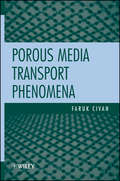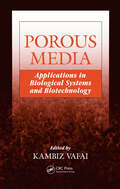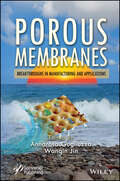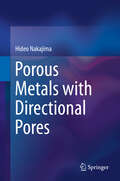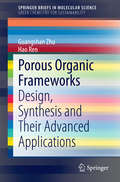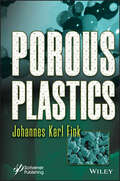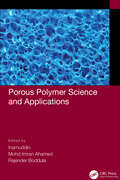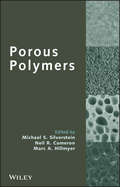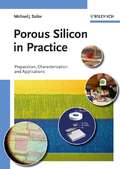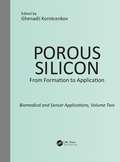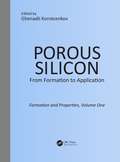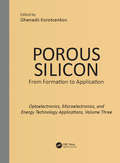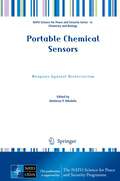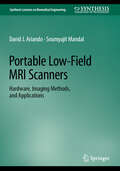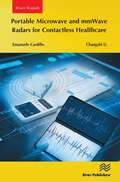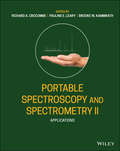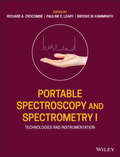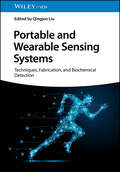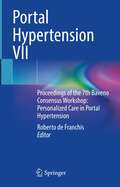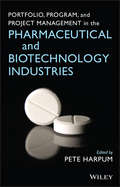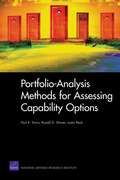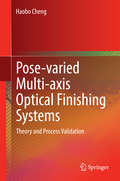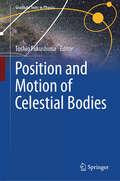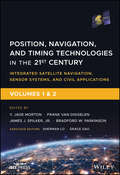- Table View
- List View
Porous Media Transport Phenomena
by Faruk CivanThe book that makes transport in porous media accessible to students and researchers alikePorous Media Transport Phenomena covers the general theories behind flow and transport in porous media-a solid permeated by a network of pores filled with fluid-which encompasses rocks, biological tissues, ceramics, and much more. Designed for use in graduate courses in various disciplines involving fluids in porous materials, and as a reference for practitioners in the field, the text includes exercises and practical applications while avoiding the complex math found in other books, allowing the reader to focus on the central elements of the topic.Covering general porous media applications, including the effects of temperature and particle migration, and placing an emphasis on energy resource development, the book provides an overview of mass, momentum, and energy conservation equations, and their applications in engineered and natural porous media for general applications. Offering a multidisciplinary approach to transport in porous media, material is presented in a uniform format with consistent SI units.An indispensable resource on an extremely wide and varied topic drawn from numerous engineering fields, Porous Media Transport Phenomena includes a solutions manual for all exercises found in the book, additional questions for study purposes, and PowerPoint slides that follow the order of the text.
Porous Media: Applications in Biological Systems and Biotechnology
by Kambiz VafaiPresenting state-of-the-art research advancements, Porous Media: Applications in Biological Systems and Biotechnology explores innovative approaches to effectively apply existing porous media technologies to biomedical applications. In each peer-reviewed chapter, world-class scientists and engineers collaborate to address significant problems and d
Porous Membranes: Breakthroughs in Manufacturing and Applications
by Annarosa Gugliuzza Wanqin JinThe book is essential for anyone seeking a deep understanding of porous membranes, as it offers valuable insights into manufacturing methods, innovative applications, and strategies for optimizing membrane design to meet critical project demands across various fields. Porous Membranes: Breakthroughs in Manufacturing and Applications is a comprehensive guide to discovering the world of porous membranes and their applications. This volume gives a global perspective of basic concepts, featuring manufacturing approaches and potential applications where control of pore size and shape, and distribution can be decisive for the success of a membrane process. In-depth explanations elaborate on the key role assigned to a membrane’s pores in directing events that are crucial for the mandatory targets imposed by a project’s requirements. Further, discussions on how to manage and characterize materials from a molecular to macro scale to achieve highly defined architecture to enable high-performing separations are explored. Advances and innovation are central themes, providing useful solutions to current critical aspects and existing bottlenecks in the control of structural and chemical features of targeted membranes. This cross-disciplinary discussion opens new routes for membrane science in expanding fields, including water management, environmental remediation, recovery of targeted compounds, food, and health. Readers will find this book: Introduces the strict relationship between extensively ordered porous membranes and enhanced productivity; Explores new approaches based on new membrane pore concepts; Emphasizes the feasibility and reliability of the proposed techniques within the context of a potential scale-up, analyzing critical issues and traits; Focuses on the role of porous membranes in some strategic membrane operations, providing clear evidence about the fundamental role of structure-separation properties for the success of membrane processes dedicated to natural resource management. Audience Researchers in chemistry, biology, biomedicine, materials science, textiles, and electronics who are involved with membranes and materials; technologists and product managers from industry, including those responsible for research and development, building prototypes and commercial devices, will find this book to be especially valuable.
Porous Metals with Directional Pores
by Hideo NakajimaThis book reviews the recent development of fabrication methods and various properties of lotus-type porous metals and their applications. The nucleation and growth mechanism of the directional pores in metals are discussed in comparison with a model experiment of carbon dioxide pores in ice. Three casting techniques are introduced to produce not only metals and alloys but also intermetallic compounds, semiconductors, and ceramics: mold casting, continuous zone melting, and continuous casting. The latter has merits for mass production of lotus metals to control porosity, pore size and pore direction. Furthermore, anisotropic behavior of elastic, mechanical properties, thermal and electrical conductivity, magnetic properties, and biocompatibility are introduced as peculiar features of lotus metals.
Porous Organic Frameworks
by Hao Ren Guangshan ZhuThis book describes the design, synthesis, characterization and applications of porous organic frameworks (POFs). Special emphasis is placed on the utilization of porous materials for CO2 capture and CH4 and H2 storage, which have promising potential for addressing the issues of environmental degradation and climate change. It also includes two chapters introducing the properties of POFs and defining the principles of synthesis, as well as a chapter dealing with post-modified POFs. This book is intended for those readers who are interested in porous materials and their applications. Guangshan Zhu is a professor at the College of Chemistry, Jilin University, China.
Porous Plastics
by Johannes Karl FinkPOROUS PLASTICS A unique book by a well-known polymer scientist on a subject that is trending in plastics/polymer engineering. Porous polymers are materials that are having pores in their design. Porous polymers are important for various fields of application and are used with pores of different sizes, i.e., from macropores to micropores. This book focuses on the issues of porous polymers as well as low molecular compounds that can be introduced in porous polymers. The book begins with a chapter about polymers that are used for porous materials. Here, among others, microporous polymer networks, hyper-crosslinked polymers, and rigid ladder-type porous polymers are detailed. Related issues are also detailed in the subsequent chapters. In the next chapter, the major synthesis methods for porous polymers are described. Then, the properties and material testing methods, such as standards, are described in a chapter. In the following chapters, special fields of applications of porous polymers are described in detail, such as: medical uses, thermal insulation, membranes, separation methods, and other fields of use. Audience The book will be used by plastics engineers, materials scientists and polymer scientists/researchers in both industry and academia./p>
Porous Polymer Science and Applications
by Inamuddin Mohd Imran Ahamed Rajender BoddulaPorous Polymer Science and Applications aims to provide recent developments and advances in synthesis, tuning parameters, and applications of porous polymers. This book brings together reviews written by highly accomplished panels of experts working in the area of porous polymers. It encompasses basic studies and addresses topics of novel issues concerning the applications of porous polymers. Chapter topics span basic studies, novel issues, and applications addressing all aspects in a one-stop reference on porous polymers. Applications discussed include catalysis, gas storage, energy and environmental sectors making this an invaluable guide for students, professors, scientists and R&D industrial experts working in the field of material science and engineering and particularly energy conversion and storage. Additional features include: Provides a comprehensive introduction to porous polymers addressing design, synthesis, structure, properties and characterization. Covers task-specific applications of porous polymers. Explores the advantages and opportunities of these materials for most major fields of science and engineering. Outlines novel research areas and potential development and expansion areas.
Porous Polymers
by Marc A. Hillmyer Michael S. Silverstein Neil R. CameronThis book gathers the various aspects of the porous polymer field into one volume. It not only presents a fundamental description of the field, but also describes the state of the art for such materials and provides a glimpse into the future. Emphasizing a different aspect of the ongoing research and development in porous polymers, the book is divided into three sections: Synthesis, Characterization, and Applications. The first part of each chapter presents the basic scientific and engineering principles underlying the topic, while the second part presents the state of the art results based on those principles. In this fashion, the book connects and integrates topics from seemingly disparate fields, each of which embodies different aspects inherent in the diverse field of porous polymeric materials.
Porous Silicon in Practice
by M. J. SailorBy means of electrochemical treatment, crystalline silicon can be permeated with tiny, nanostructured pores that entirely change the characteristics and properties of the material. One prominent example of this can be seen in the interaction of porous silicon with living cells,which can be totally unwilling to settle on smooth silicon surfaces but readily adhere to porous silicon, giving rise to great hopes for suchfuture applications as programmable drug delivery or advanced, braincontrolled prosthetics. Porous silicon research is active in the fieldsof sensors, tissue engineering, medical therapeutics and diagnostics, photovoltaics, rechargeable batteries, energetic materials, photonics,and MEMS (Micro Electro Mechanical Systems). Written by an outstanding, well-recognized expert in the field, this book provides detailed, step-by-step instructions to prepare and characterize the major types of porous silicon. It is intended for those new to the fi eld. Sampling of topics covered: * Principles of Etching Porous Silicon* Etch Cell Construction and Considerations* Photonic Crystals, Microcavities, and Bragg Stacks Etched in Silicon* Preparation of Free-standing Films and Particles of Porous Silicon* Preparation of Photoluminescent Nanoparticles from Porous Silicon* Preparation of Silicon Nanowires by Electrochemical Etch of Silicon* Surface Modifi cation Chemistry and Biochemistry* Measurement of Optical Properties* Measurement of Pore Size, Porosity, Thickness, Surface AreaThe whole is backed by a generous use of color photographs to illustrate the described procedures in detail, plus a bibliography of furtherliterature pertinent to a wide range of application fi elds. For materials scientists, chemists, physicists, optical physicists, biomaterialsscientists, neurobiologists, bioengineers, and graduate students in those fields, as well as those working in the semiconductor industry.
Porous Silicon: From Formation to Application: Biomedical and Sensor Applications, Volume Two
by Ghenadii KorotcenkovPorous silicon is rapidly attracting increasing interest from various fields, including optoelectronics, microelectronics, photonics, medicine, chemistry, and biosensing. This nanostructured and biodegradable material has a range of unique properties that make it ideal for many applications. For example, the pores and surface chemistry of the mater
Porous Silicon: From Formation to Application: Formation and Properties, Volume One
by Ghenadii KorotcenkovPorous silicon is rapidly attracting increasing interest in various fields, including optoelectronics, microelectronics, photonics, medicine, chemistry, biosensing, and energy. Porous Silicon: Formation and Properties fills a gap in the literature of the field today, providing a thorough introduction to current knowledge of the formation, processin
Porous Silicon: Opto- And Microelectronic Applications
by Ghenadii KorotcenkovPorous silicon is rapidly attracting increasing interest from various fields, including optoelectronics, microelectronics, photonics, medicine, sensor and energy technologies, chemistry, and biosensing. This nanostructured and biodegradable material has a range of unique properties that make it ideal for many applications. This book, the third of a
Portable Biosensing of Food Toxicants and Environmental Pollutants (Series in Sensors)
by Dimitrios P. Nikolelis Georgia-Paraskevi Nikoleli Theodoros Varzakas Arzum ErdemBiosensors are poised to make a large impact in environmental, food, and biomedical applications, as they clearly offer advantages over standard analytical methods, including minimal sample preparation and handling, real-time detection, rapid detection of analytes, and the ability to be used by non-skilled personnel. Covering numerous applications
Portable Chemical Sensors
by Dimitrios P. NikolelisBiosensors are making a large impact in environmental, food, biomedical, and other applications. In comparison to standard analytical detection methods, such as minimal sample preparation and handling, they offer advantages including real time detection, rapid detection of the analytes of concern, use of non-skilled personnel, and portability. The aim of this book is to focus on research related to the rapid detection of agents and weapons of bioterrorism and provide a comprehensive review of the research topics most pertinent to advancing devices applicable to the rapid real-time detection of toxicants such as microbes, pathogens, toxins, or nerve gases. The ongoing war on terrorism and the rising security concerns are driving the need for newer faster biosensors against bio-warfare agents for both military and civil defence applications. The volume brings together contributions from the most eminent international researchers in the field, covering various aspects of work not so far published in any scientific journal and often going beyond the "state of art " . Readers of these review articles will learn new technological schemes that can lead to the construction of devices that will minimize the risk of bio-terrorism.
Portable Low-Field MRI Scanners: Hardware, Imaging Methods, and Applications (Synthesis Lectures on Biomedical Engineering)
by Soumyajit Mandal David J. AriandoThis book provides readers with an accessible and up-to-date introduction to the field of low-field MRI, which is currently seeing a resurgence in both research and commercial activity. It begins by presenting a historical overview of MRI system design and discussing current developments. It then analyzes the underlying physics of MRI from a semi-classical perspective before describing the major hardware components of low-field scanners (including the magnet, coils, transmitters, receivers, gradient systems, and digital processors) in detail. Several examples of each component are described to solidify the reader’s understanding of the major challenges and trade-offs involved in designing these complex devices. Finally, the issues involved in integrating these components within a working system are highlighted by presenting the architecture, design, and test results of two fully functional low-field MRI scanners that were designed and developed by the authors.
Portable Microwave and mmWave Radars for Contactless Healthcare
by Emanuele Cardillo Changzhi LiThis book is dedicated to modern radars, describing their working principles and providing an overview on recent applications of microwave and mmWave radars for healthcare applications.For many years, the scientific community has put significant effort into the development of advanced microwave and mmWave radar systems for healthcare applications. Young students, researchers, and professionals need a reference book which clearly and concisely describes the main principles of portable radars and identify the relevant applications of this technology.This book is both an entry point for students and researchers new to the topic and a reference for those seeking to explore specific aspects of radar technologies in healthcare. Ultimately, the authors hope to inspire joint efforts directed towards new innovative theories, technologies, techniques, and applications of modern biomedical radar.
Portable Spectroscopy and Spectrometry, Applications
by Henry C. Lee Richard A. Crocombe Pauline E. Leary Brooke W. KammrathThe most comprehensive resource available on the many applications of portable spectrometers, including material not found in any other published work Portable Spectroscopy and Spectrometry: Volume Two is an authoritative and up-to-date compendium of the diverse applications for portable spectrometers across numerous disciplines. Whereas Volume One focuses on the specific technologies of the portable spectrometers themselves, Volume Two explores the use of portable instruments in wide range of fields, including pharmaceutical development, clinical research, food analysis, forensic science, geology, astrobiology, cultural heritage and archaeology. Volume Two features contributions by a multidisciplinary team of experts with hands-on experience using portable instruments in their respective areas of expertise. Organized both by instrumentation type and by scientific or technical discipline, 21 detailed chapters cover various applications of portable ion mobility spectrometry (IMS), infrared and near-infrared (NIR) spectroscopy, Raman and x-ray fluorescence (XRF) spectroscopy, smartphone spectroscopy, and many others. Filling a significant gap in literature on the subject, the second volume of Portable Spectroscopy and Spectrometry: Features a significant amount of content published for the first time, or not available in existing literature Brings together work by authors with assorted backgrounds and fields of study Discusses the central role of applications in portable instrument development Covers the algorithms, calibrations, and libraries that are of critical importance to successful applications of portable instruments Includes chapters on portable spectroscopy applications in areas such as the military, agriculture and feed, hazardous materials (HazMat), art conservation, and environmental science Portable Spectroscopy and Spectrometry: Volume Two is an indispensable resource for developers of portable instruments in universities, research institutes, instrument companies, civilian and government purchasers, trainers, operators of portable instruments, and educators and students in portable spectroscopy courses.
Portable Spectroscopy and Spectrometry, Technologies and Instrumentation
by Richard A. Crocombe Pauline E. Leary Brooke W. KammrathProvides complete and up-to-date coverage of the foundational principles, enabling technologies, and specific instruments of portable spectrometry Portable Spectroscopy and Spectrometry: Volume One is both a timely overview of the miniature technologies used in spectrometry, and an authoritative guide to the specific instruments employed in a wide range of disciplines. This much-needed resource is the first comprehensive work to describe the enabling technologies of portable spectrometry, explain how various handheld and portable instruments work, discuss their potential limitations, and provide clear guidance on optimizing their utility and accuracy in the field. In-depth chapters—written by a team of international authors from a wide range of disciplinary backgrounds—have been carefully reviewed both by the editors and by third-party experts to ensure their quality and completeness. Volume One begins with general discussion of portable spectrometer engineering before moving through the electromagnetic spectrum to cover x-ray fluorescence (XRF), UV-visible, near-infrared, mid-infrared, and Raman spectroscopies. Subsequent chapters examine microplasmas, laser induced breakdown spectroscopy (LIBS), nuclear magnetic resonance (NMR) spectroscopy, and a variety of portable mass spectrometry instrument types. Featuring detailed chapters on DNA instrumentation and biological analyzers—topics of intense interest in light of the global coronavirus pandemic—this timely volume: Provides comprehensive coverage of the principles and instruments central to portable spectroscopy Includes contributions by experienced professionals working in instrument companies, universities, research institutes, the military, and hazardous material teams Discusses special topics such as smartphone spectroscopy, optical filter technology, stand-off detection, and MEMS/MOEMS technology Covers elemental spectroscopy, optical molecular spectroscopy, mass spectrometry, and molecular and imaging technologies Portable Spectroscopy and Spectrometry: Volume One is an indispensable resource for developers of portable instruments, civilian and government purchasers and operators, and teachers and students of portable spectroscopy. When combined with Volume Two, which focuses on the multitude of applications of portable instrumentation, Portable Spectroscopy and Spectrometry provides the most thorough coverage of the field currently available.
Portable and Wearable Sensing Systems: Techniques, Fabrication, and Biochemical Detection
by Qingjun LiuPortable and Wearable Sensing Systems Discover the sensors of the future with this comprehensive guide Chemical sensors and biosensors have advanced enormously in recent decades, driven by growth in other technological areas and the refinement of manufacturing processes. Advances, especially, in wireless technology and flexible electronics have dramatically increased the practicality and availability of portable or wearable sensing systems. These have the potential to revolutionize disease diagnosis, food analysis, and environment monitoring at the point of care. Portable and Wearable Sensing Systems: Techniques, Fabrication, and Biochemical Detection introduces these groundbreaking technologies and the underlying principles which make them possible. Beginning with an overview of the foundational optics and electrochemistry which power these systems, the book surveys methods of fabrication, applications, and projected future developments. The result is a comprehensive introduction to an essential medical and biochemical technology. Portable and Wearable Sensing Systems readers will also find: Treatment of body fluid detection, exhaled breath sensing, ingestible devices, and moreDetailed discussion of sensing system types including scattering, colorimetric, and chemiluminescenceForward-looking attention to the latest advances in every chapter Portable and Wearable Sensing Systems is ideal for analytical chemists, materials scientists, bioengineers, biochemists, and anyone working with sensing technologies.
Portal Hypertension VII: Proceedings of the 7th Baveno Consensus Workshop: Personalized Care in Portal Hypertension
by Roberto De FranchisThis book, the seventh in a series of proceedings volumes that began in 1995, reviews the latest developments in the diagnosis and management of cirrhosis and portal hypertension. It addresses a broad range of topics, including: risk stratification, HVPG, non-invasive surrogates for cACLD, CSPH, varices, progression and regression of cirrhosis, impact of etiological therapy on cirrhosis, impact of non-etiological novel therapies on cirrhosis, prevention of first/further decompensation, acute variceal hemorrhage, and Vascular Liver Disorders in Cirrhosis (VALDIG).The book is a compilation of lectures and important consensus statements from the Seventh Baveno International Consensus Workshop on Portal Hypertension, the latest in a series of workshops held every five years for hepatologists with an interest in the field. Portal Hypertension VII offers a valuable reference guide for clinical and research fellows in Gastroenterology and Hepatology and will inspire new research projects in the promising areas identified by the experts of the Baveno VII Faculty.
Portfolio, Program, and Project Management in the Pharmaceutical and Biotechnology Industries
by Pete HarpumThis book describes the way that pharmaceutical projects and programs are currently managed, and offers views from many highly experienced practitioners from within the industry on future directions for drug program management. The book integrates portfolio, program, and project management processes as fundamental for effective and efficient drug product development. Contributing expert authors provide their view of how the projectization approach can be taken forward by the drug industry over the coming years.
Portfolio-Analysis Methods for Assessing Capability Options
by Justin Beck Paul K. Davis Russell D. ShaverAn analytical framework and methodology for capability-area reviews is described, along with new tools to support capabilities analysis and strategic-level defense planning in the Defense Department and the Services. BCOT generates and screens preliminary options, and the Portfolio-Analysis Tool (PAT) is used to evaluate options that pass screening. The concepts are illustrated with applications to Global Strike and Ballistic Missile Defense. Recommendations are made for further defense-planning research.
Pose-varied Multi-axis Optical Finishing Systems
by Haobo ChengThis book focuses on advanced optical finishing techniques and design for high-performance manufacturing systems. It provides numerous detailed examples of how advanced automation techniques have been applied to optical fabrication processes. The simulations, removal rate and accurate experimental results offer useful resources for engineering practice. Researchers, engineers and graduate students working in optical engineering and precision manufacture engineering will benefit from this book.
Position and Motion of Celestial Bodies (Graduate Texts in Physics)
by Toshio FukushimaThis book is a systematic introduction to astrometry and celestial mechanics. It consists of five parts: Observational astrometry, theoretical astrometry, basics of celestial mechanics, orbital dynamics, and rotational dynamics. The book is unique in various aspects. First, it discusses astrometry and celestial mechanics in a single and unified manner. Second, it stands on not the Newtonian but general relativistic viewpoints. Third, it explains both the orbital and rotational motions of celestial bodies. Fourth, it conforms to the latest International Astronomical Union (IAU) resolutions and Conférence Générale des Poids et Mesures (CGPM) rules. Lastly, its historical topics, ample exercises, and detailed model answers stimulate readers. The appendixes also provide various tables of constants, basic mathematical formulae, descriptions of symbols used, lists of technical abbreviations and model solutions to exercises. The book is intended for undergraduate students of physics or astronomy. Further, it serves as a pocket reference also useful for professional scientists. The basis of the English translation of this book from its Japanese original manuscript was done with the help of artificial intelligence. A subsequent human revision of the content was done by the editor and authors.
Position, Navigation, and Timing Technologies in the 21st Century, Volumes 1 and 2: Integrated Satellite Navigation, Sensor Systems, and Civil Applications, Set
by Sherman Lo Grace GaoCovers the latest developments in PNT technologies, including integrated satellite navigation, sensor systems, and civil applications Featuring sixty-four chapters that are divided into six parts, this two-volume work provides comprehensive coverage of the state-of-the-art in satellite-based position, navigation, and timing (PNT) technologies and civilian applications. It also examines alternative navigation technologies based on other signals-of-opportunity and sensors and offers a comprehensive treatment on integrated PNT systems for consumer and commercial applications. Volume 1 of Position, Navigation, and Timing Technologies in the 21st Century: Integrated Satellite Navigation, Sensor Systems, and Civil Applications contains three parts and focuses on the satellite navigation systems, technologies, and engineering and scientific applications. It starts with a historical perspective of GPS development and other related PNT development. Current global and regional navigation satellite systems (GNSS and RNSS), their inter-operability, signal quality monitoring, satellite orbit and time synchronization, and ground- and satellite-based augmentation systems are examined. Recent progresses in satellite navigation receiver technologies and challenges for operations in multipath-rich urban environment, in handling spoofing and interference, and in ensuring PNT integrity are addressed. A section on satellite navigation for engineering and scientific applications finishes off the volume. Volume 2 of Position, Navigation, and Timing Technologies in the 21st Century: Integrated Satellite Navigation, Sensor Systems, and Civil Applications consists of three parts and addresses PNT using alternative signals and sensors and integrated PNT technologies for consumer and commercial applications. It looks at PNT using various radio signals-of-opportunity, atomic clock, optical, laser, magnetic field, celestial, MEMS and inertial sensors, as well as the concept of navigation from Low-Earth Orbiting (LEO) satellites. GNSS-INS integration, neuroscience of navigation, and animal navigation are also covered. The volume finishes off with a collection of work on contemporary PNT applications such as survey and mobile mapping, precision agriculture, wearable systems, automated driving, train control, commercial unmanned aircraft systems, aviation, and navigation in the unique Arctic environment. In addition, this text: Serves as a complete reference and handbook for professionals and students interested in the broad range of PNT subjects Includes chapters that focus on the latest developments in GNSS and other navigation sensors, techniques, and applications Illustrates interconnecting relationships between various types of technologies in order to assure more protected, tough, and accurate PNT Position, Navigation, and Timing Technologies in the 21st Century: Integrated Satellite Navigation, Sensor Systems, and Civil Applications will appeal to all industry professionals, researchers, and academics involved with the science, engineering, and applications of position, navigation, and timing technologies.pnt21book.com
